You can actually use your own body weight to pin the koala against the tree/fence. You use press down on its forehead to stop it climbing and call for assistance. This produces a fanciful picture in my head as I imagine myself discovered in some unlawful position, a frightened koala wedged between myself and a tree...
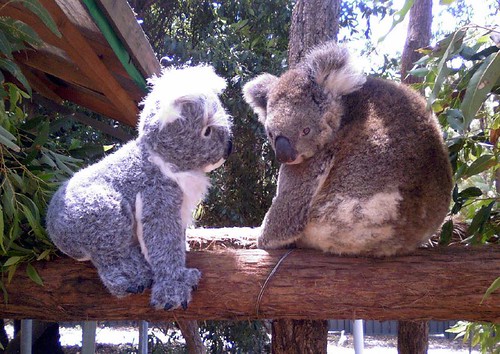
Birthday Girl & friend
From koalawrangler's gallery.
Today Cheyne held a koala handling and rescue training workshop using both real and toy koalas. Can you tell the difference?
A bunch of us koala-wrangling novices signed up and we got to learn the best way to pick up a koala -- both in day-to-day handling and rescue situations. (I can't say that I ever expected my life to contain the potential for "day-to-day koala handling", but there you have it).
We all sat around the day-room table -- there are a few familiar faces such as Yasmin from Thursdays and Jules the tour guide, as well as about 10 others I haven't met before. I guess these must be the volunteers for the other days. It's hard to imagine this place with others doing the job you do on your own shift -- you maintain the illusion that the place goes into suspended animation when you're gone. It's also hard to imagine others tending to the koalas you've been looking after. The connection feels so intimate, probably because we translate the koalas' natural passivity into trust and affection. I know I feel it and I've noticed how ardently some of the long-term koala volunteers express the relationship they perceive between themselves and a particular koala. Some of these people have been tending to the koalas for years and the result is often a fierce if one-sided bond. I overhear that Oxley Griffin and Pacific Sam have both been released since I was last here. My immediate reaction is: I shared something with these little critters and now they're gone.
Someone brandishes a copy of the Port Macquarie News. They had printed an article about little Cloud, the tiny grey koala who was badly burnt in the 1994 bush fires but lived in the koala hospital for the next 13 years. She was euthanased on Saturday. Another woman who I think was the team-leader for the afternoon shift said, "well, I can't read that now or I'll cry. There's been a lot of tears shed over this koala and no-one deserves to cry about it more than me. I was closer to Cloud than anyone". She pushed the article aside and returns her eyes to the day-book. It's an urgent affection I've also found myself feeling after only a few short weeks, so I can understand something of her sentiment.
Cheyne bustles into the room in her usual blue v-neck hospital blouse and shorts. She's laid two large koala-rescue poles on the floor and assembled a koala-rescue kit for us to see. Before the session starts, Cheyne tells us that if any of us are interested in fire-ground work then we should tell her at the end. By fire-ground she means searching areas where fires have come through for surviving koalas. I don't know if I could do it -- I read about the demise of Perch Miracle on the Hospital website, a koala who was literally heat-sealed to her tree. Still she was rescued and survived for some years before she died unexpectedly. Cheyne warns us that it is dangerous work -- you need to undertake fire awareness training offered by the state before you are allowed onto the fire-ground site.
But today we are to begin simply with how to approach a koala with the intention of picking it up. I'm delighted when she refers to the skills involved as a sort of "koala whispering". We consult the handout she has provided, entitled Basic Koala Handling. The priority is to ensure no injuries are sustained by the handler -- if the handler is okay, there is a better chance that the koala will be okay.
We talk about how to read koala body language. If you get bitten or scratched by the koala, you're probably doing something wrong. There is a lengthy list of signs to look for that carry meanings that can be deciphered by the koala-whisperer-trained eye: ear-flicking (which I first experienced with Tozer Tom back on my first day) can mean pain or irritation. Eye-popping is also a sign of fear, which they often see in koalas on the treatment table. Some signs are more ambiguous; a very quiet koala can mean it is very ill or just good-tempered.
Cheyne raises the interesting point of anthropomorphism, essentially ascribing an animal with human characteristics or projecting human feelings onto them. For example, a koala might extend its face towards its handler in a Kiwi greeting fashion. This is a gesture seeking smell recognition, not affection! Equally, when a contented koala reaches its arms towards you, it is not for a hug; it's in order to get more formula or leaf. Cheyne's intention appears to be to shatter our fragile illusions about the bond we imagine we have with the koalas. According to Cheyne, we are simply "walking formula/leaf" to the koalas. We all joke that of course we knew that, but secretly harbour our own convictions that, "no, they really love me! My relationship with them is special!"
She also shatters another illusion: koalas aren't too bright as a species. They are simply not very intelligent; they have a basic plan. I wait for her to say "eats, shoots and leaves". Geoff offers "eats, sleeps and makes nuggets (poop)" instead. Cheyne tells us that the koala brain is not very convoluted, but is instead fairly smooth. Its spheres are also quite separate. The wombat, the koala's closing relative, is actually smarter. Cheyne hastens to add that "more advanced" doesn't mean better: just look at humans and how well we've screwed things up for ourselves.
So we've got to think like koalas and not like humans, whatever that means. Some koalas are just "fruitcakes"; that is, wild and unpredictable in human terms, but the way koalas should be. These are generally the koalas that have had very little to do with humans, like those from the Ellenborough region. The local koalas are used to people, which is not really a good thing. So fruitcake = good, unless you're trying to rescue one.
We go outside with the equipment and into yard 9 where the permanent girls are. We're not going to each be able to pick up a koala today -- "the poor thing'll be worn out", says Cheyne. But she gives us a demonstration on one of the girls. The first thing is to give the koala some warning of your intentions by speaking softly and gently running your hand up the koala's back. This seems counter-intuitive to me; my experience with our cat is to do everything quickly before she has a chance to scratch/bite, like wait till she's asleep before sneaking up on her and stuffing her quickly in the catbox. But this is not how koalas are made. They're not braced to attack, but can be unpredictable especially after undergoing a trauma.
Jules the guide wants to know how to get a koala to release its "Arnold Schwarzenegger grip" on the gunyah/tree. Because their claws are not retractable, it's difficult to lift them off -- but, to return to the cat analogy, it's not like they're gripping to resist you, they simply can't release their claws if you're pulling against them. The key is to slip your fingers under their wrists and push their forearm forward to release their claws. Cheyne demonstrates on Wiruna Lucky, one of the placid gang-of-four girls in yard 9. She looks slightly piqued, but submits. Cheyne also demonstrates how to stop a koala from advancing: simply press its forehead gently. The same technique is used to stop a koala climbing up a tree.
The handout talks about three types of koalas: quiet, bitey, and frightened. I can't help but think of cheese when I read "bitey", as in Bega Strong & Bitey vintage cheddar. The "quiet" koalas need less precautionary measures than bitey or frightened koalas. Even if you are aware of all the signs to read that indicate fear or irritation, Cheyne says that a koala may look placid enough but could have cortisol (a stress hormone) coursing through its body (making it a fruitcake-in-waiting).
Most of the koalas we tend in the hospital seem quiet, but then I haven't had to pick one up yet. Where a koala is "bitey", it's recommended that you enjoy it with water crackers and a slice of cabanossi... just kidding! With the bitey ones you let them know you're coming as with the quiet variety, but you place a thick towel around their shoulders and arms and then place your arms under the towel edges to protect yourself from a potential bite as you lift them up. You should try to keep the dangling koala at arm's length and even swing them foward as it may craftily try to swing its legs backwards to grab you with its back claws. Bitey and scratchy! Also, koalas should never be picked up under the arms or around the ribs.
With even more tetchy koalas (the really "frightened" kind), a bag is used. Bagging is the primary means of securing koalas during a rescue. Although, Cheyne suggested that this is often best-case scenario; sometimes a rescuer has to use whatever means is at their disposal at the time. For example, if you suddenly need to stop a koala from escaping a yard -- say one that is scaling a fence, or in a rescue situation when a koala is descending a tree -- you can actually use your own body weight to pin the koala against the tree/fence. You use press down on its forehead to stop it climbing and call for assistance. This produces a fanciful picture in my head as I imagine myself discovered in some unlawful position, a frightened koala wedged between myself and a tree. Cheyne assures us: "It won't hurt them; it's better than letting them escape".
The bag used is made of canvas. Often the handler has to assess the situation to determine the angle of approach. The bag can be place over the head and brought back to the rump or can be slid from the rump up over the head; whatever method gets the koala in the bag with the least amount difficulty and stress for both animal and human is best. Oh, and once the koala is in the bag, it generally pees straight away (which is exactly what Treetop Boxer did when he was first transferred outside, prior to his release). If the koala is being brought into ICU for treatment, it's best to know which 'end' they need. Sometimes it's the bottom for an injection or the top for feeding. Either way, it's best to try to keep the rest of the koala in the bag (it's less stressful for them) and expose only the end requiring jabbing or feeding.
At this point, Ocean Therese decides to wander over to see what was happening (or more likely to see if Cheyne has any formula for her). Cheyne mock-rouses on her then plucks her off the gunyah and proceeds to hold her in such an expert yet cuddlesome way...show-off! :)
Next we look at what's involved in a rescue, when the koala is not right in front of you on the gunyah, but half a kilometre up a tree. We're using a fake koala, so no koalas were hurt or injured in the course of this rescue! The best scenario involves three handlers: two with poles and one with a bag to catch the koala at the other end. We each have a go at holding the pole. It's not enough to just hold it; you have to hold the full weight of it up above your head. "Imagine holding that up for twenty minutes, chasing a koala that's springing from branch to branch", says Cheyne. The healthy koalas are the hardest to catch.
The pole resembles a paint roller. It has a flat end wrapped in a towel. This is used to press down on the koala's forehead like Cheyne showed us. Of course, that was on a koala immediately in front of us. In the reality of a rescue I can see how it would be like trying to use this huge pole to thread a needle. The two pole-wielders ease the koala down to the bagger at the bottom. But it's a mistake to think that a koala will just back into the bag; it will try to hightail it back up the tree as soon as it can. You need to place the bag over its head and manoeuvre its claws upward to disengage them from the trunk. Sounds so easy. Oh, and make sure you avoid thwacking powerlines with your pole. If the koala is too high, that's when to call in Country Energy to bring over a cherry-picker.
Cheyne also shows us how to 'pack' a koala. They use two washing baskets; one filled with rolled up towels and another for a lid. The koala is nestled into the basket and then covered with the other basket, which is tied on with bike cord. It's also important to cover the basket to prevent the koala from being further distressed. The last thing it needs after it has experienced trauma is staring human faces. This is especially true of joeys and victims of dog attacks or motor vehicle accidents (MVA). These koalas should also be handled a little differently; they should never be held up by the arms since they may have undergone a fracture or internal injuries. It's best to wrap these koalas up in a towel and pack them securely with a rolled up towel at each side. They should also be kept upright to keep their passageways clear in case of lung damage. Another type of koala to be aware of in rescue situations are those that are blind. They may run in circles in a disorientated fashion.
I noticed on the boards inside that all the aviary koala have been moved to the new small subdivisions in yard 10. At least they are outside now, except that this means they are without proper shelter. I go to see how they are faring. At least someone has erected a pot high on the middle vertical branch so that there is some shelter overhead. I'm happy for Macquarie Peter, who I've now seen progress from ICU to an aviary to the yards. The girls are out here too: Ellenborough Kelly and Newport Bridge Gloria. I also check on Elizabeth Noddy who wakes up to greet me.
Click here to view more of today's koala hospital photos.
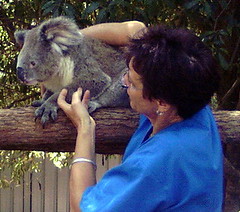
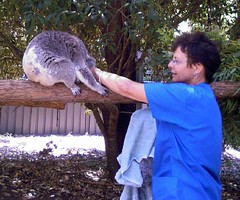
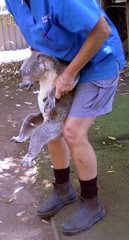
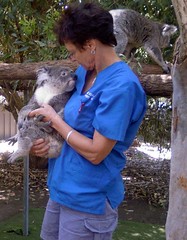
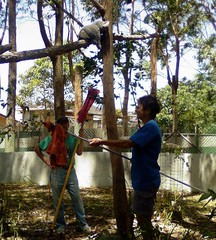
No comments:
Post a Comment